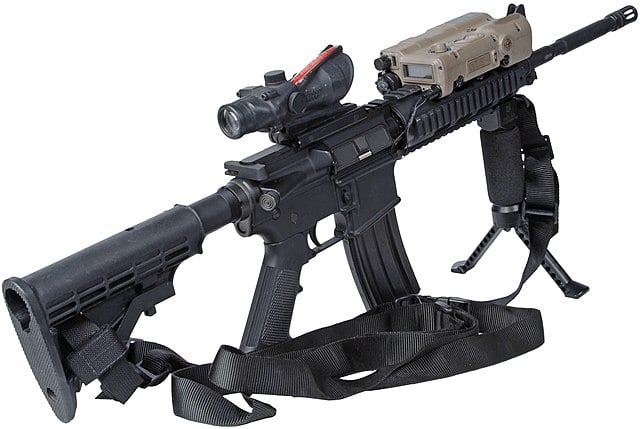The Fighting 10/22? A Primer On Rimfire Carbines

Believe it or not, a rimfire carbine such as the ever-popular Ruger 10/22 makes more sense than many people might be willing to admit.
They are cost-effective to buy and run, and they are 50-state legal. The .22 LR is fully capable of penetration to a sufficient depth from a rifle-length barrel. Further, they’re mostly more innocuous than other platforms and easier for almost anyone to pick up and make hits with.
There are pitfalls, of course, so it’s not that they’re perfect. Nothing in this life is. With that said, though, they tick far more boxes than some might necessarily realize.
So…let’s discuss the general concept, its use cases, and major weaknesses and go over an equipment list if we were to seriously consider the idea.
Why A .22 Carbine Is A Better Choice Than Many Think
Besides the apparent justifications of cost (Ruger 10/22s are relatively cheap; other common rimfire carbines are as well) of both the rifle and ammunition, it’s that .22 LR punches above its weight in some regards when launched from a rifle.
It’s not about what it doesn’t do, it’s about what it does.
40-grain round-nose lead at rifle velocities is capable of penetrating to FBI ammunition test depth of 12 inches or better in ballistic gel tests. Dr. Martin Fackler documented as much over 20 years ago.
Agile Training & Consulting, owner and principal instructor Chuck Haggard, has been saying for years on various appearances and podcasts that he never went to a shooting involving a .22 rifle that wasn’t a homicide.
And never forget that Bella Twin bagged a world-record grizzly bear with a single-shot .22 rifle.
So, the bullet can poke a deep enough hole at reasonable distances, which is undoubtedly sufficient for urban and suburban environments.
However, .22 LR is certainly not very good at barrier penetration and worse than useless at stopping (key idea) four-legged threats. Yes, it killed bears, but stopping a bear and merely killing one aren’t the same things. Small predators, like coyotes, are certainly within its purview at reasonable distances.
The guns are cheaper to buy, cheaper to feed, and are 50-state legal. You can even buy them in New York.
Who Benefits Most From A Rimfire Carbine?


The rimfire carbine has several great use cases in a defensive role.
The first is a surreptitious fighting rifle. Since they’re peashooters – bound to be brought up in the comments – they aren’t taken as seriously and, therefore, aren’t as offensive to urban liberals as, say, a Benelli M4 or an AR-15.
Capably armed but seemingly innocuous? That’s a benefit. For the person who travels frequently, living out of their car, camper, RV, or boat, and may have to worry about crossing into various jurisdictions? Also a benefit.
Second is for anyone who has a physical impediment to a larger platform such as an intermediate carbine (AR, AK, lever gun) or shotgun. The elderly, the extremely petite (battle gnomes and battle gnomesses) and the disabled won’t have the issues they might with another platform.
That also makes one a tenable pool weapon as well.
And, let’s face it…you’ll never have to work too hard to be able to shoot one fairly well at home defense distances. For the person who just can’t (or won’t) put in a lot of time behind the gun, it doesn’t take a lot of work.
Necessary Accessories


Of course, any platform you’d choose for home defense should have a light. A sling for a purely house gun is arguably optional, though still a good idea.
Perhaps the greatest weakness of the 10/22 specifically is the base model’s lack of sling mounts. Granted, plenty of people have screwed studs into stocks over the years.
Mounting the light is the hard part. Few factory rimfire carbines are designed to mount any accessories besides a forward sling swivel. A few are – the Winchester Wildcat has a Picatinny rail molded into the forend – and select 10/22 models have upgraded stocks, such as those by Magpul with M-LOK slots.
Otherwise, you may have to resort to a sling swivel-mounted rail or a degree of inelegant ingenuity. For instance, you can bolt stuff to a wood stock and add a little contact cement for reinforcement.
Optics are always better than irons, but some of the rimfire carbines actually have decent factory sights. The 10/22 is not among them unless you buy a variant with the receiver-mounted peep sight. Plenty of affordable red dots from Sig Sauer, Vortex, and others would be an excellent fit here.
Another must is a supply of magazines. The rotary box magazines, such as Rugers’, are generally excellent. However, other rimfire platforms that use box magazines are known for being finicky. Rossi/Mossberg or Savage 64 owners should vet magazines to ensure reliability. If one gives you problems, toss it and buy another one.
However, given the relative abundance of accessories…adding a light, an optic, and a few magazines is a relative cakewalk. Easy to buy, easy to run, easy to outfit…that’s an awful lot of positives so long as it fits your use case. Given that most of the US population resides in urban or suburban areas, that’s a lot more people than one might think.
Read the full article here






